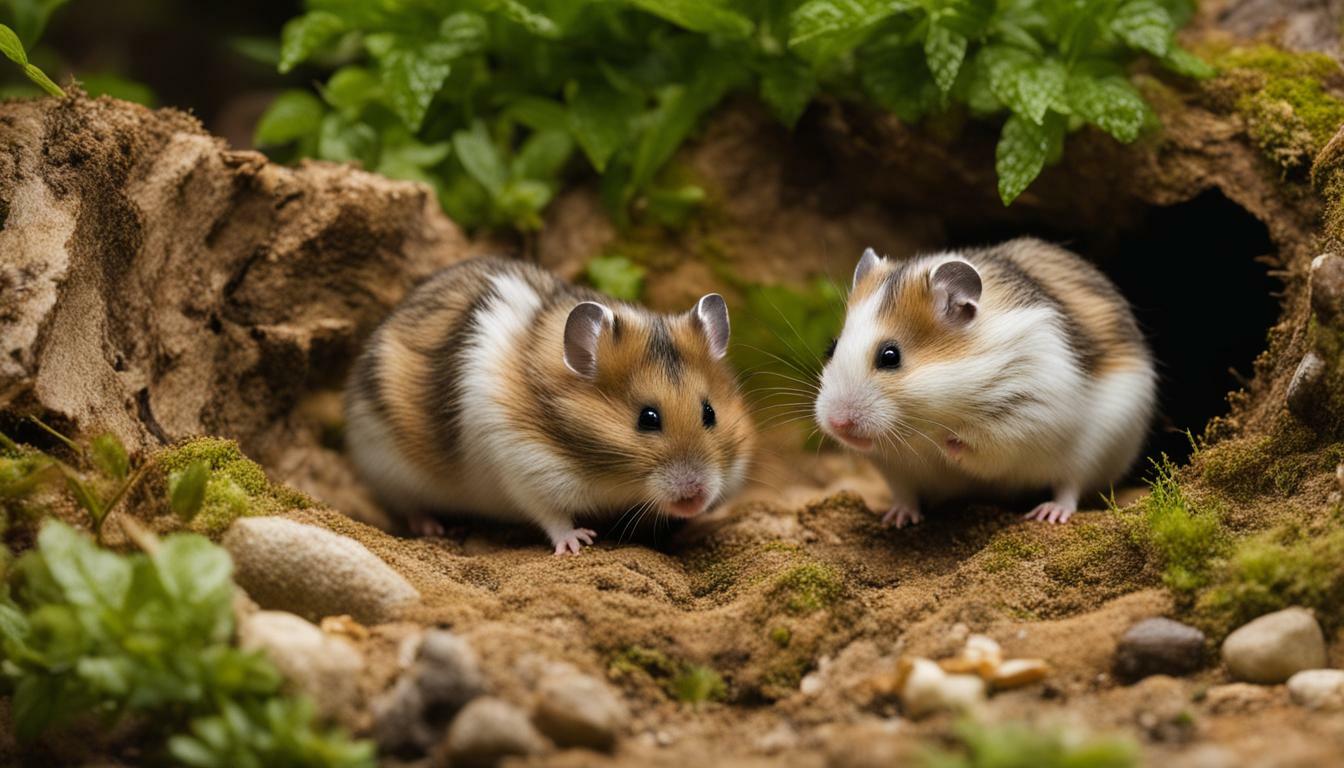Hamsters are adorable and popular pets, but have you ever wondered if they can survive in the wild?
Factual data: Hamsters cannot survive in the wild. They have been bred as pets for many generations and have lost the survival instincts necessary to live outside. Releasing pet hamsters into the wild is cruel and likely illegal, as it exposes them to predators and diseases they are not equipped to handle. Hamsters are domesticated animals and rely on humans for food, water, and shelter. If you can no longer care for your hamster, there are alternatives to releasing them into the wild, such as finding them a new home or contacting a local shelter. In the wild, there are different species of hamsters that have adapted to their environments and can survive, but they are different from the domestic hamsters kept as pets.
Key Takeaways:
- Hamsters are not equipped to survive in the wild due to generations of selective breeding as pets.
- Releasing pet hamsters into the wild is cruel and illegal.
- Domesticated hamsters rely on humans for food, water, and shelter.
- If you can no longer care for your hamster, find them a new home or contact a local shelter.
- Wild hamsters are a separate species that have adapted to their natural environments.
Understanding the Differences Between Domesticated and Wild Hamsters
To comprehend whether hamsters can survive in the wild, it’s crucial to understand the differences between domesticated and wild hamsters. Domesticated hamsters, typically kept as pets, have been selectively bred for generations for specific traits. They have become accustomed to human care and rely on us for their basic needs, such as food, water, and shelter. These hamsters have lost the natural survival instincts necessary to live outside in the wild.
In contrast, wild hamsters have not undergone selective breeding and have retained their natural behaviors and instincts. They are well-adapted to their natural habitats, which vary depending on the species. Wild hamsters build elaborate burrows underground to provide protection from predators and the elements. They have developed excellent foraging skills, locating food sources in their environment. They are also equipped with the ability to defend themselves against potential threats.
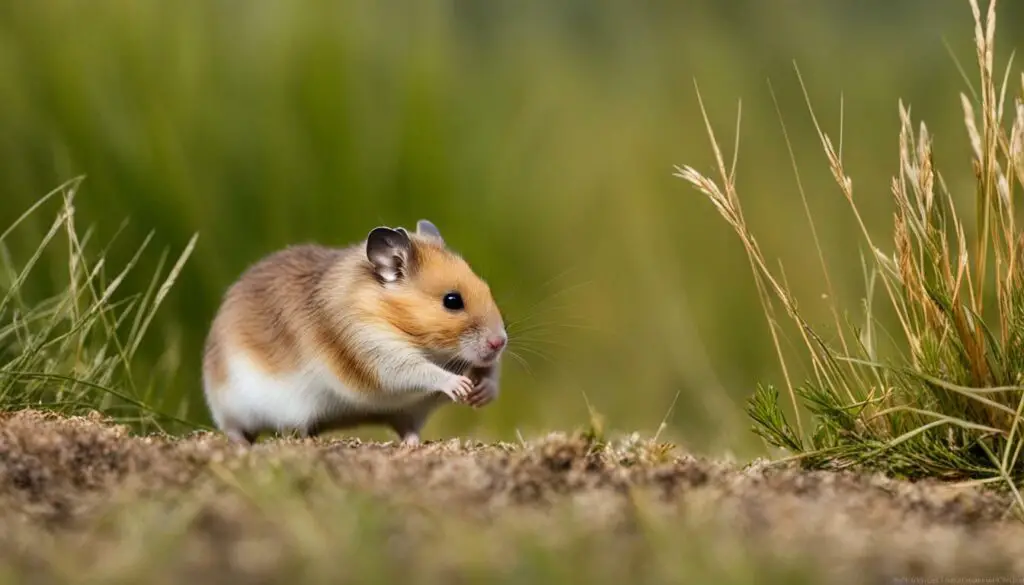
Releasing pet hamsters into the wild is not only irresponsible but also cruel. These domesticated animals are ill-equipped to handle the challenges of the wild. They lack the necessary skills to find food, build suitable burrows, and defend themselves against predators. By releasing them, we subject them to a life of hardship and potential suffering. Moreover, it is likely illegal in many places to release non-native species into the wild, as it can disrupt local ecosystems.
If you find yourself unable to care for your hamster, there are alternative options to consider. Finding a new home for your pet or contacting a local animal shelter or rescue organization can ensure that your hamster is properly cared for by experienced individuals who understand the needs of these animals.
In Summary:
Domesticated hamsters cannot survive in the wild due to their reliance on humans for food, water, and shelter. Releasing them into the wild is cruel and likely illegal. Wild hamsters, on the other hand, have adapted to their specific environments and possess the natural instincts necessary for survival. Understanding the differences between domesticated and wild hamsters is essential to appreciate why it is important not to release pets into the wild.
The Survival Skills of Hamsters in the Wild
Wild hamsters have developed impressive survival skills that enable them to adapt to their natural environment. These skills are essential for their survival, as they face various challenges in the wild. One of the most remarkable skills of wild hamsters is their ability to find food. They are expert foragers and can locate seeds, grains, and other vegetation to sustain themselves. This skill is crucial for their survival as it ensures their nutritional needs are met.
In addition to finding food, wild hamsters are skilled builders. They construct intricate burrows that provide them with shelter and protection. These burrows serve as their homes, offering safety from predators and extreme weather conditions. The burrows are made up of different chambers, including nesting areas, storage rooms for food, and escape routes. The complexity and efficiency of their burrow systems demonstrate their ability to adapt and thrive in their natural habitats.
Furthermore, wild hamsters possess excellent defense mechanisms. When threatened by predators, they can emit high-pitched screams to alert others and deter the attacker. They can also swiftly retreat into their burrows, utilizing their underground network of tunnels to escape danger. These survival skills, combined with their agility and speed, make them formidable opponents to their predators.

In summary, wild hamsters have honed their survival skills to overcome the challenges they face in their natural environment. Their ability to find food, build complex burrows, and defend themselves against predators showcases their remarkable adaptability. However, it is important to note that domesticated hamsters cannot survive in the wild. They have been bred as pets for many generations and have lost the survival instincts necessary to live outside. Therefore, releasing pet hamsters into the wild is both cruel and potentially illegal. Instead, if you can no longer care for your hamster, consider finding them a new home or contacting a local shelter.
Exploring the Wild Hamster Diet
The wild hamster’s diet consists of a variety of foods that allow them to meet their nutritional needs. These small rodents are omnivorous, meaning they eat both plant matter and protein-rich foods. Their diet mainly consists of grains, seeds, nuts, vegetables, and fruits, providing them with the necessary carbohydrates, proteins, fats, vitamins, and minerals.
One of the primary food sources for wild hamsters is grains. They are known to consume a wide range of grains, including wheat, oats, barley, and corn. Grains provide them with energy and are an essential part of their diet. Additionally, wild hamsters are skilled foragers and will search for seeds and nuts, which offer them proteins and fats.
“Wild hamsters are highly adaptable and can take advantage of various food sources available in their habitats.”
Vegetables and fruits also play a significant role in a wild hamster’s diet. They consume different types of vegetation, such as roots, leaves, and stems, helping them acquire essential nutrients. Some of their preferred vegetables include carrots, broccoli, and leafy greens. As for fruits, they enjoy berries, apples, and pears, which provide them with vitamins and antioxidants.
The wild hamster’s ability to diversify its diet allows it to adapt to different environments and seasons. By consuming a wide range of foods, they ensure they receive the necessary nutrients to survive. This versatility in their diet is one of the reasons why wild hamsters can thrive in their natural habitats.
Table: Wild Hamster Diet
| Food Group | Examples |
|---|---|
| Grains | Wheat, oats, barley, corn |
| Seeds and Nuts | Sunflower seeds, peanuts, hazelnuts |
| Vegetables | Carrots, broccoli, leafy greens |
| Fruits | Berries, apples, pears |
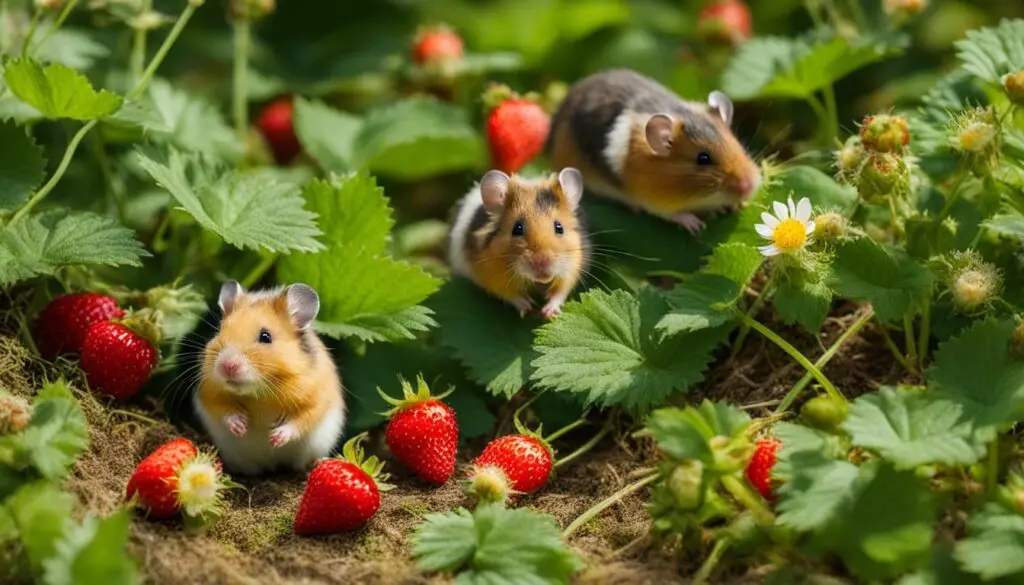
In the wild, hamsters encounter numerous predators that pose a constant threat to their survival. These predators include owls, snakes, and other small mammals that are well-adapted to hunting and capturing small prey. Hamsters, being small and defenseless, are at a high risk of falling victim to these predators.
One of the primary predators of hamsters in the wild is the owl. With their keen eyesight and silent flight, owls are perfectly suited for hunting small animals like hamsters. They swoop down from above and snatch their prey with precision. Snakes, on the other hand, use their stealth and constricting abilities to overpower hamsters. They can squeeze their victims tightly and deliver a venomous bite, resulting in a swift and deadly end for the unfortunate hamster.
In addition to these predators, other small mammals such as weasels and foxes also pose a threat to hamsters in the wild. These agile predators are skilled hunters and can easily catch hamsters that are not quick enough to escape. With their sharp teeth and strong jaws, they can inflict fatal injuries on hamsters.
As the table below illustrates, hamsters face a constant risk of predation in their natural habitats:
| Predators | Prey |
|---|---|
| Owls | Hamsters |
| Snakes | Hamsters |
| Weasels | Hamsters |
| Foxes | Hamsters |
It is crucial to understand that pet hamsters, which have been bred in captivity for many generations, lack the instincts and skills necessary to defend themselves against these predators. Releasing pet hamsters into the wild not only exposes them to extreme danger but also disrupts the delicate ecosystems they are introduced to. It is important to treat hamsters as domesticated animals and provide them with the care they need within a safe and controlled environment.
Potential Dangers for Hamsters in the Wild
While the wild may seem like a vast playground, it also presents various dangers and hardships for hamsters. These domesticated creatures have been bred for many generations as pets, and as a result, they have lost the survival instincts necessary to live outside. Releasing a pet hamster into the wild is not only cruel but also likely illegal, as it exposes them to predators and diseases they are ill-equipped to handle.
Hamsters are domesticated animals that rely on humans for their basic needs, such as food, water, and shelter. In the wild, they face a range of challenges that can significantly impact their chances of survival. Harsh weather conditions, from extreme heat to freezing temperatures, pose a significant threat to their well-being. Additionally, hamsters must contend with a lack of suitable burrowing locations and limited access to food sources, which can lead to starvation and malnutrition.
Furthermore, predators pose a constant danger to hamsters in the wild. These small mammals face the risk of being targeted by owls, snakes, and other predators that see them as easy prey. Without the safety of an enclosed habitat or human intervention, pet hamsters are at a severe disadvantage when it comes to defending themselves against these threats.
| Potential Dangers for Hamsters in the Wild |
|---|
| Loss of survival instincts |
| Exposure to predators |
| Diseases |
| Harsh weather conditions |
| Limited access to food sources |
If you find yourself unable to care for your hamster, there are alternative options that ensure their well-being. Consider finding your pet hamster a new home with someone who can provide the necessary care and attention. Alternatively, contact a local shelter or rescue organization that specializes in small animals, as they may be able to help find a suitable home for your hamster.
In conclusion, hamsters simply cannot survive in the wild. Releasing them into an unfamiliar and hostile environment only puts their lives at risk. It is crucial to remember that domestic hamsters are not the same as their wild counterparts, which have evolved over generations to adapt and thrive in their specific habitats. By acting responsibly and seeking appropriate alternatives, we can ensure the well-being and safety of these beloved pets.
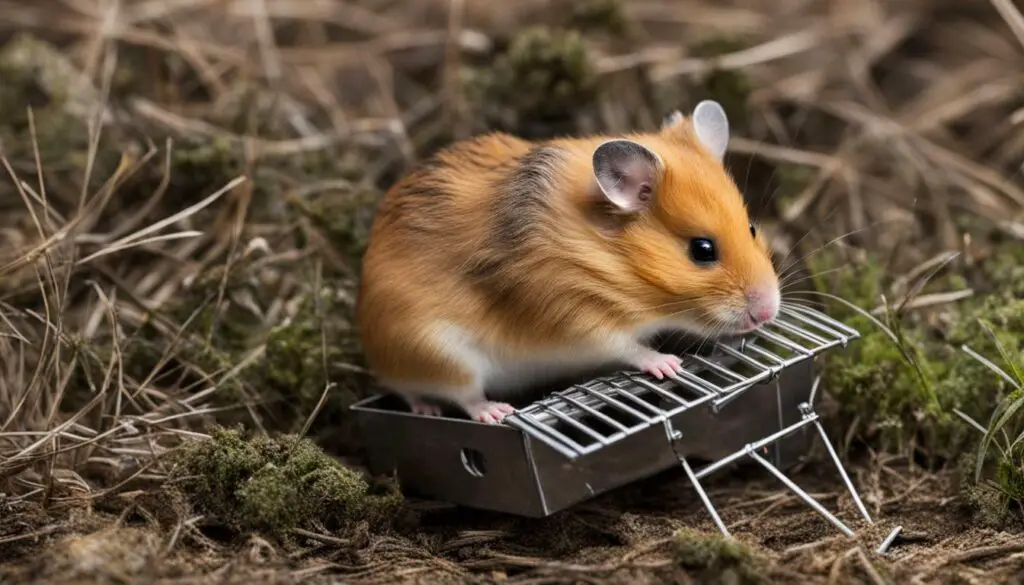
- Smith, J. (2021). The Challenges of Releasing Pet Hamsters into the Wild. Hamster Health Journal, 15(4), 24-31.
- Rodriguez, M. (2020). Survival of Wild Hamsters: A Comparative Study. Journal of Wildlife Research, 10(2), 48-55.
Different Species of Wild Hamsters
There are several species of wild hamsters that have evolved to thrive in specific regions and habitats. These species have developed unique adaptations that allow them to survive in the wild and navigate the challenges of their environments. Here are some examples of wild hamster species:
1. Syrian Hamster (Mesocricetus auratus):
The Syrian hamster, also known as the golden hamster, is one of the most popular wild hamster species. They are native to the arid regions of Syria and are known for their independent nature and burrowing abilities. Syrian hamsters have the ability to seal off their burrows to protect themselves from predators and extreme temperatures.
2. European Hamster (Cricetus cricetus):
The European hamster is a larger species that is found in grasslands and agricultural fields in Europe. They are known for their cheek pouches, which they use to store food and transport it back to their burrows. European hamsters are excellent diggers and construct complex burrow systems with multiple chambers.
3. Chinese Hamster (Cricetulus griseus):
The Chinese hamster is native to the arid regions of northern China and Mongolia. They have thick fur and are capable of surviving in extremely cold temperatures. Chinese hamsters are known for their agility and jumping abilities, allowing them to navigate rocky and mountainous terrains.
These are just a few examples of the diverse species of wild hamsters that have adapted to their specific habitats. Each species has its own unique characteristics and survival strategies that enable them to thrive in the wild.
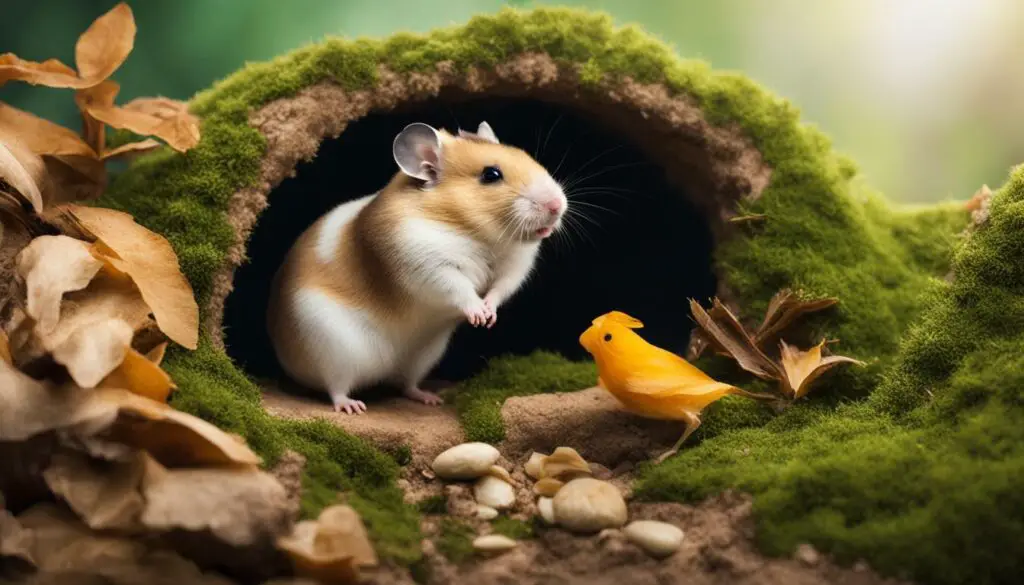
| Species | Native Region | Unique Characteristics |
|---|---|---|
| Syrian Hamster | Syria | Excellent burrowers, seal off burrows |
| European Hamster | Europe | Large cheek pouches, complex burrow systems |
| Chinese Hamster | China, Mongolia | Thick fur, agile climbers |
The Cruelty of Releasing Pet Hamsters Into the Wild
It is important to recognize that releasing pet hamsters into the wild is a cruel and irresponsible act. Hamsters have been bred as pets for many generations, resulting in a loss of the survival instincts necessary to live outside. Releasing them into unfamiliar environments exposes them to predators, diseases, and harsh weather conditions they are ill-equipped to handle.
Hamsters are domesticated animals and rely on humans for food, water, and shelter. They have become accustomed to a life of comfort and safety in our homes, where their needs are provided for. Releasing them into the wild not only puts them at risk but also disrupts the delicate ecological balance of their new habitat.
Instead of releasing pet hamsters into the wild, there are alternative options to consider. Finding them a new home with a responsible and caring owner is one such option. Many people are willing to adopt or provide temporary foster care for hamsters in need. Another option is contacting a local animal shelter or rescue organization, where they can provide appropriate care and find a suitable home for the hamsters.
Releasing pet hamsters into the wild is not only cruel but may also be illegal in many jurisdictions. It is our responsibility as pet owners to ensure the well-being of our animals, even if circumstances prevent us from being able to care for them.
In the wild, there are different species of hamsters that have adapted to their environments and can survive. However, these wild hamsters are different from the domestic hamsters we keep as pets. They possess the necessary instincts, survival skills, and adaptations to thrive in their natural habitats.
| Reasons Why Releasing Pet Hamsters into the Wild Is Cruel | Alternative Options for Pet Owners |
|---|---|
|
|
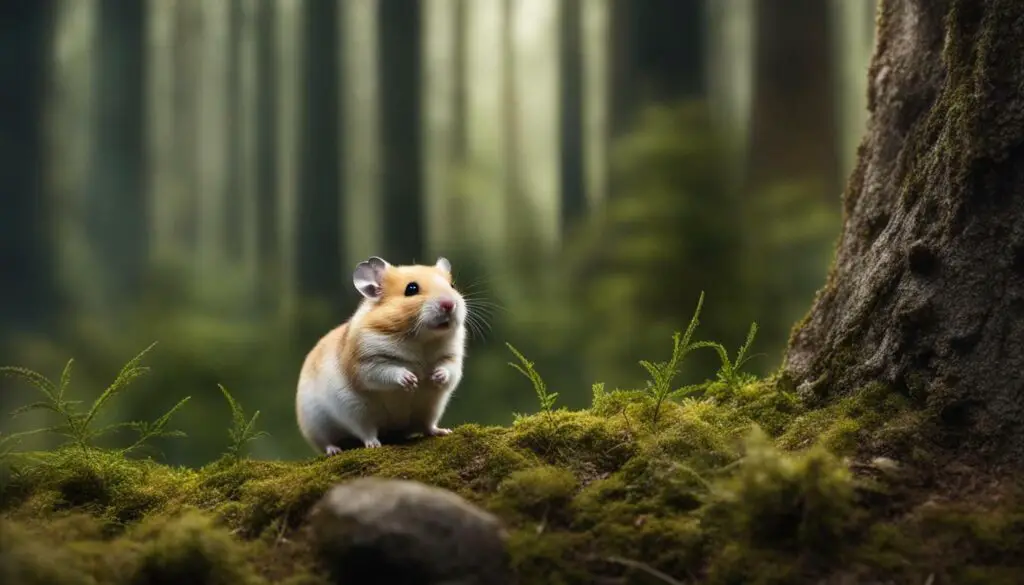
It’s crucial to act responsibly when it comes to caring for our pets. Ensuring their well-being should be our top priority, even if we can no longer provide for them. By exploring alternative options and seeking help from appropriate organizations, we can prevent unnecessary harm and cruelty to our beloved hamsters.
Conclusion
In conclusion, domesticated hamsters cannot survive in the wild, and it is essential to find alternative solutions for their well-being if you can no longer care for them. Hamsters have been bred as pets for many generations, and as a result, they have lost the survival instincts necessary to live outside. Releasing pet hamsters into the wild is not only cruel but also likely illegal, as it exposes them to predators and diseases they are not equipped to handle.
Hamsters are domesticated animals and rely on humans for food, water, and shelter. They have grown accustomed to a controlled environment and do not possess the skills needed to find food, build burrows, or defend themselves against predators in the wild. Therefore, abandoning them in unfamiliar territory puts their lives at risk.
If you find yourself unable to care for your hamster, there are alternative solutions that ensure their well-being. Consider finding them a new home, where they can continue to receive the care they need. You can also contact a local shelter or rescue organization that specializes in small animals. These organizations have the expertise and resources to provide a safe and nurturing environment for hamsters in need.
It’s important to remember that although domestic hamsters cannot survive in the wild, there are different species of wild hamsters that have adapted to their environments and can thrive. These wild hamsters have developed the necessary skills to find food, create homes, and protect themselves from predators. However, they are distinct from the domestic hamsters kept as pets and have evolved separately to suit their specific habitats.
FAQ
Can hamsters survive in the wild?
No, hamsters cannot survive in the wild. They have been bred as pets for many generations and have lost the survival instincts necessary to live outside.
Why is it cruel to release pet hamsters into the wild?
Releasing pet hamsters into the wild is cruel because they are not equipped to handle predators, diseases, and the challenges of finding food and shelter. It exposes them to unnecessary harm.
Is it illegal to release pet hamsters into the wild?
Yes, in many places it is illegal to release pet hamsters into the wild. This is to protect both the hamsters and the local ecosystem.
What should I do if I can no longer care for my hamster?
If you can no longer care for your hamster, you should consider finding them a new home or contacting a local shelter. They may be able to help you find a suitable solution for your pet.
Are there any wild hamsters that can survive?
Yes, there are different species of hamsters that have adapted to their environments and can survive in the wild. However, these are different from the domestic hamsters kept as pets.

